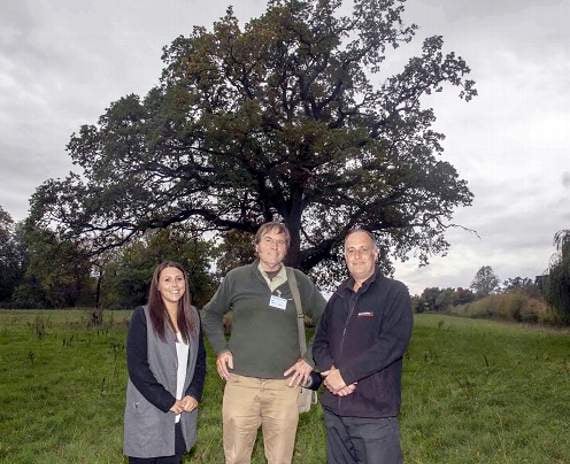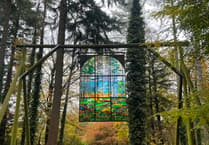IT’S not difficult to find trees in the Forest of Dean – the clue is in the name, after all – but where exactly are the oldest specimens? The ones which have the potential to become a part of the landscape for hundreds of years? Those which are important to people and communities?
They are some of the questions being asked by a project which has recruited local volunteers to go out into the Forest and record the location and characteristics of these particularly special trees.
The ancient and notable trees project is gathering information to help increase awareness of their ecological and cultural importance while the closely linked veteran trees investigation hopes to add to the understanding of the development of the Forest over the last 400 years.
So what is an ancient tree? A veteran tree? A notable tree?
That can be tricky to pin down precisely, says woodlands advisor Paul Rutter, who is leading the ancient and notable trees project on behalf of Foresters’ Forest, the Lottery-funded partnership raising awareness of the Dean’s environment, culture and history.
Mr Rutter, who works for conservation experts PlantLife said: “It is tricky to define – basically an ancient tree is very old.
“Ancient is a generic term for a tree that has reached its stage of what is called post-maturity so that can be over 150 years old for one species or it could be 300 years for another.
“A notable tree has the potential to become ancient and needs looking after, so we want to flag those up and improve the habitat over time.
“Losing those means there is no replacement for the old things.
The veteran tree is the one with signs of age, that has damage, has lost its limb, it’s got hollows in it, it has fungi on it and those things are part of the biodiversity of a tree as it ages.
“The bigger and older a tree the more veteran it becomes. Even hollow trees can be valuable because they may support some rare insects inside them.”
The Review spoke to Mr Rutter at Oaklands Park, the Victorian estate at Newnham where he was leading a training session for volunteers highlighting the difference between ancient, veteran and notable trees and how to record them.
He said: “I’m supporting Foresters’ Forest as a partner with a project that is based around trees of the Forest of Dean and the Hundred of St Briavels that are in need of sympathetic management.
“They haven’t always been understood to be a valuable part of our ecosystem and they are the ancient and notable trees.
“The Forest has lost many of its big old trees because they have been felled.
“There are many which are developing but they are hidden away inside the Forest and around plantations.
“They support an enormous amount of wildlife whether that is animals and insects spending time and living around them or eating off them.
“They also support lichen and lots of plants which live on the trees.
“The older they are the more valuable they are in terms of biodiversity.
“The survey has got lots of people together – local surveyors, supporters – to go out and record the tree, its location and its characteristics so we can put together on a map where all these trees are located to help with future management.
“When they have the training, it is up to individuals to go out and look at the trees which they think are very important to them or that stand out as being important in ecological terms.”
There are around 30 volunteers being trained to go out and survey trees but the project also hopes to hear from locals who think they have a tree of note in their area and they are being asked to send in information through the main project website, www.forestersforest.uk
Mr Rutter said: “We are interested in hearing from anyone who wants to record the old trees or the one that are really special to them.”
The three-year project aims to work with both the Forestry Commission and private landowners to increase awareness of ancient and notable trees.
Mr Rutter said: “The Forestry Commission is setting up a new Forest Plan and some of that we, hope, will be informed by the tree information we give them so they know where these old trees are.
“They know that foresters need to manage them in a certain ways. They are quite sensitive so they don’t want damage being done around them or vegetation being planted too close to them.
“They are thinking more about it so that will inform the future management so that the foresters can manage them sensitively and appropriately.
“On privately owned land we are going to talk to the landowners and explain the benefits of these trees but also how to look after them themselves.”
Among the volunteers at the training day at Oaklands Park last Thursday (October 11) was Kate Blinston of Newnham, who is already involved as a surveyor on the Batscape project which is looking at the flying mammals.
She said: “We’ve been seeing these really good trees, so linking up with the notable and ancient tree survey means that when we are looking at bat habitats, we can also spot the trees as well.”
Sarah Howells of Natural England, who is leading the Batscape project, said: “We are working with farmers and landowners to improve the connectivity of the hedgerow network and other features within the landscape.”
Working with experts from the Gloucestershire Bat Group, the project is concentrating on horseshoe bats, and the Forest and Lower Wye Valley are an important stronghold for them.
Ms Howells added: “We have a number of maternity roosts and winter roosts where the bats can hibernate and we want to work with the farmers and landowners who are managing the land that surrounds those roosts to make it more bat-friendly
Batscape volunteers are carrying out surveys to get a better idea of the condition of the hedgerows.
“It’s good to have Paul to train up the volunteers a bit more to look at the trees within the hedgerows and within the landscape.”
-------------
“This is a happy tree”
THIS oak at Oaklands Park is a good example of a happy tree, says woodlands expert Paul Rutter.
He pointed it out to volunteers on a training day being held at the Camphill Village Trust property just outside Newnham.
He said: “It has low branches which have not been cut off, which a lot of people will do.
“It is in open pasture so lots of light and it is a happy tree. Non-stressed trees are happy trees.
“This is what trees want to do and if you think of how many trees get to do this it is a pretty rare thing.
“We want more of those but we have to give them space – it has got protection around the base of the tree, it has promise.
“What we have found in the Forest of Dean is that they have been managed as forest trees, not as ancient trees and that means they grow very close together, they grow very upright, they have few low limbs and are cut down when they are about 130 years old for timber.”
The Dean is a working forest which means there is not a completely free hand to manage ancient trees in a particular way although it is hoped information from the ancient and notable trees survey will ‘inform’ the Forestry Commission’s forthcoming Forest Plan.
But there are very practical reasons for making life as stress-free for trees, said Mr Rutter.
“It was only last week that we were hearing that stressed trees are vulnerable to disease.
“There are lots of diseases of trees at the moment and they are increasing.
“Having low-stressed trees reduces their vulnerability to diseases.”





Comments
This article has no comments yet. Be the first to leave a comment.